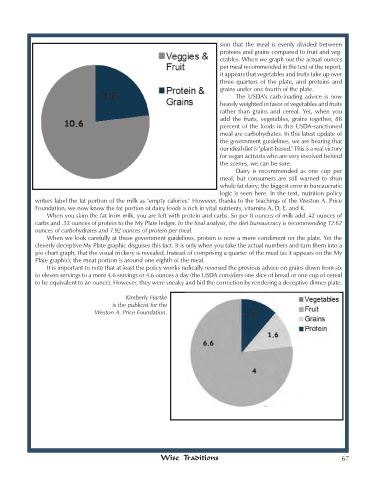Page 71 - Winter2014
P. 71
sion that the meal is evenly divided between
proteins and grains compared to fruit and veg-
etables. When we graph out the actual ounces
per meal recommended in the text of the report,
it appears that vegetables and fruits take up over
three quarters of the plate, and proteins and
grains under one fourth of the plate.
The USDA’s carb-loading advice is now
heavily weighted in favor of vegetables and fruits
rather than grains and cereal. Yet, when you
add the fruits, vegetables, grains together, 88
percent of the foods in this USDA-sanctioned
meal are carbohydrates. In this latest update of
the government guidelines, we are hearing that
our ideal diet is "plant-based." This is a real victory
for vegan activists who are very involved behind
the scenes, we can be sure.
Dairy is recommended as one cup per
meal, but consumers are still warned to shun
whole fat dairy; the biggest error in bureaucratic
logic is seen here. In the text, nutrition policy
writers label the fat portion of the milk as "empty calories." However, thanks to the teachings of the Weston A. Price
Foundation, we now know the fat portion of dairy foods is rich in vital nutrients, vitamins A, D, E, and K.
When you skim the fat from milk, you are left with protein and carbs. So per 8 ounces of milk add .42 ounces of
carbs and .32 ounces of protein to the My Plate ledger. In the final analysis, the diet bureaucracy is recommending 12.62
ounces of carbohydrates and 1.92 ounces of protein per meal.
When we look carefully at these government guidelines, protein is now a mere condiment on the plate. Yet the
cleverly deceptive My Plate graphic disguises this fact. It is only when you take the actual numbers and turn them into a
pie chart graph, that the visual trickery is revealed. Instead of comprising a quarter of the meal (as it appears on the My
Plate graphic), the meat portion is around one eighth of the meal.
It is important to note that at least the policy wonks radically reversed the previous advice on grains down from six
to eleven servings to a mere 4.6 servings or 4.6 ounces a day (the USDA considers one slice of bread or one cup of cereal
to be equivalent to an ounce). However, they were sneaky and hid the correction by rendering a deceptive dinner plate.
Kimberly Hartke
is the publicist for the
Weston A. Price Foundation.
Wise Traditions WINTER 2014 Wise Traditions 67
145881_text.indd 67 12/23/14 12:17 AM

